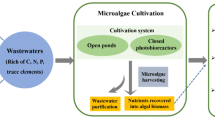Abstract
A diesel-tolerant sessile freshwater algal consortium obtained from the vicinity of Powai Lake (Mumbai, India) was cultured in the laboratory. The presence of diesel in batch cultures enhanced the maximum specific growth rate of the algal consortium. With decrease in light–dark (L:D) cycle from 20:4 to 4:20 h, the chlorophyll-a levels decreased; however, the removal of diesel was found to be maximum at L:D of 18:6 h with 37.6% degradation over and above controls. In addition to growth in the form of green clumps, white floating biomass was found surrounding the diesel droplets on the surface. This culture predominated at the least L:D ratio of 4:20 h. Studies confirmed the ability of the floating organisms to grow heterotrophically in the dark utilizing diesel as carbon source and also in the presence of light in a medium devoid of organic carbon sources.






Similar content being viewed by others
References
Radwan, S. S., Al-Hasan, R. H., Ali, N., Salamah, S., & Khanafer, M. (2005). International Biodeterioration & Biodegradation, 56, 28–33. doi:10.1016/j.ibiod.2005.03.007.
Radwan, S. S., & Al-Muteirie, A. S. (2001). Microbiological Research, 155, 301–307.
Al-Awadhi, H., Al-Hasan, R. H., Sorkhoh, N. A., Salamah, S., & Radwan, S. S. (2003). International Biodeterioration & Biodegradation, 51, 181–185. doi:10.1016/S0964-8305(02)00140-3.
Abed, R. M. M., Safi, M. M. D., Koster, J., Beer, D. D., El-Nahhal, Y., Rullkotter, J., et al. (2002). Applied and Environmental Microbiology, 68, 1674–1683. doi:10.1128/AEM.68.4.1674-1683.2002.
Oteyza, T. G., Grimalt, J. O., Diestra, E., Sole, A., & Esteve, I. (2004). Applied Microbiology and Biotechnology, 66, 226–232. doi:10.1007/s00253-004-1694-3.
Cohen, Y. (2002). International Microbiology, 5, 189–193. doi:10.1007/s10123-002-0089-5.
Al-Hasan, R. H., Al-Bader, D., Sorkhoh, N. A., & Radwan, S. S. (1998). Marine Biology (Berlin), 130, 521–527. doi:10.1007/s002270050272.
Abed, R. M. M., & Koster, J. (2005). International Biodeterioration & Biodegradation, 55, 29–37. doi:10.1016/j.ibiod.2004.07.001.
Raghukumar, C., Vipparty, V., David, J. J., & Chandramohan, D. (2001). Applied Microbiology and Biotechnology, 57, 433–436. doi:10.1007/s002530100784.
Sanchez, O., Ferrera, I., Vigues, N., Oteyza, T. G., Grimalt, J., & Mas, J. (2006). International Biodeterioration & Biodegradation, 58, 186–195. doi:10.1016/j.ibiod.2006.06.004.
Chavan, A., & Mukherji, S. (2008). Journal of Hazardous Materials, 154, 63–72. doi:10.1016/j.jhazmat.2007.09.106.
Chavan, A., & Mukherji, S. (2006). 3rd Biennial IWA Young Researchers Conference, Nanyang Technological University, Singapore, Water and Environment Management Series (pp. 169–176). UK: IWA.
Mukherji, S., Jagadevan, S., Mohapatra, G., & Vijay, A. (2004). Bioresource Technology, 95, 281–286. doi:10.1016/j.biortech.2004.02.029.
MacKinney, G. (1941). The Journal of Biological Chemistry, 140, 315–322.
Becker, E. W. (1994). Microalgae-biotechnology and microbiology. Cambridge: Cambridge University Press.
American Public Health Association, American Water Works Association and Water Environment Federation (1998) Standard methods for examination of water and wastewater.
Desikachary, T. V. (1959). Cyanophyta, monographs on algae. India: ICAR.
Burkholder, J. M., Gilbert, P. M., & Skelton, H. M. (2008). Harmful Algae, 8, 77–93. doi:10.1016/j.hal.2008.08.010.
Porra, R. J. (1990). Biochimica et Biophysica Acta, 1015, 493–502. doi:10.1016/0005-2728(90)90083-G.
Acknowledgements
This research work was partially funded by the Department of Biotechnology, New Delhi, India. The authors would like to thank Mr. Badrish Soni, BRD School of Biosciences, for discussions on characterization of the algal cultures and Mr. Praveen Kumar Mishra for his assistance in maintainance of the algal consortium. We acknowledge the Sophisticated Analytical Instrumental Facility (SAIF), IIT Bombay for facilitating microscopic examination of the cultures.
Author information
Authors and Affiliations
Corresponding author
Rights and permissions
About this article
Cite this article
Chavan, A., Mukherji, S. Response of an Algal Consortium to Diesel under Varying Culture Conditions. Appl Biochem Biotechnol 160, 719–729 (2010). https://doi.org/10.1007/s12010-009-8569-0
Received:
Accepted:
Published:
Issue Date:
DOI: https://doi.org/10.1007/s12010-009-8569-0




